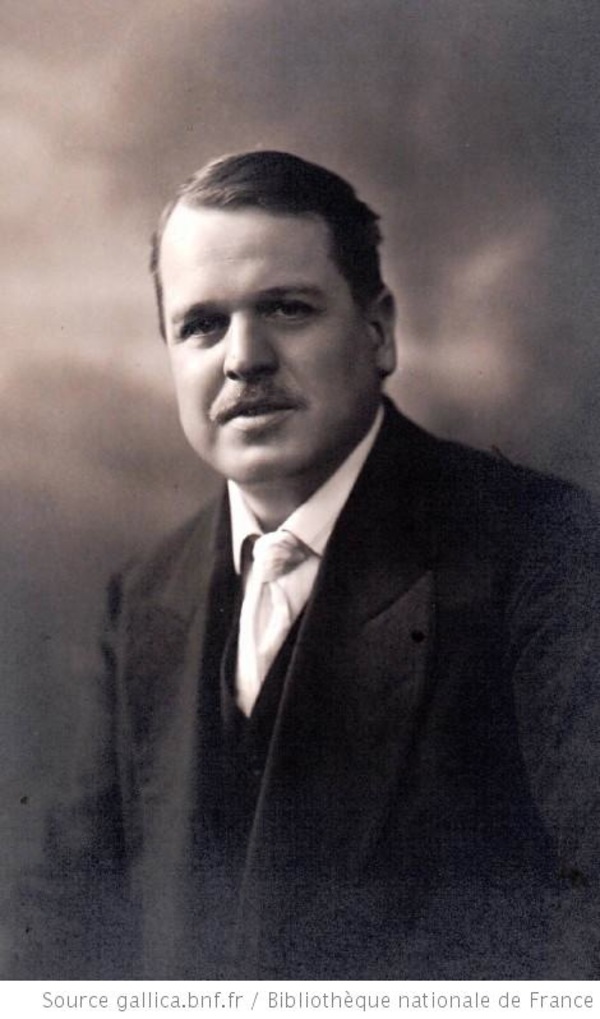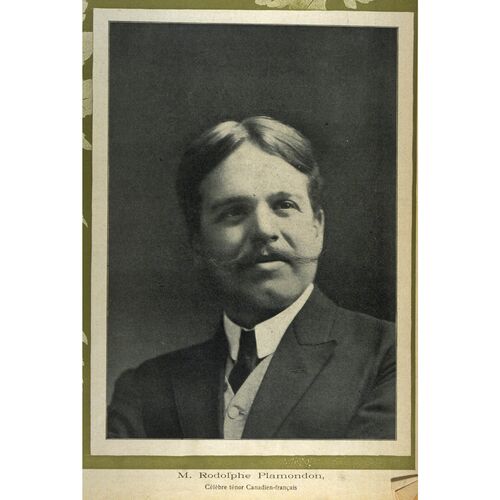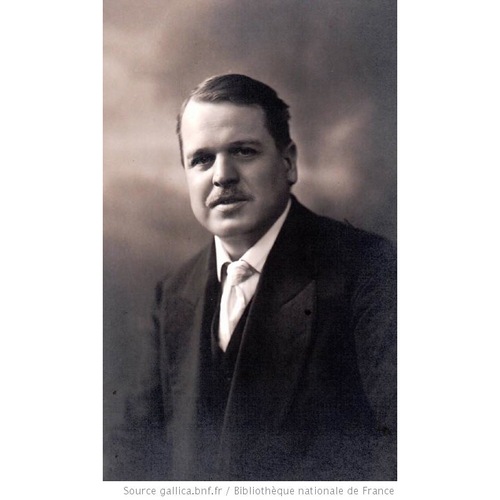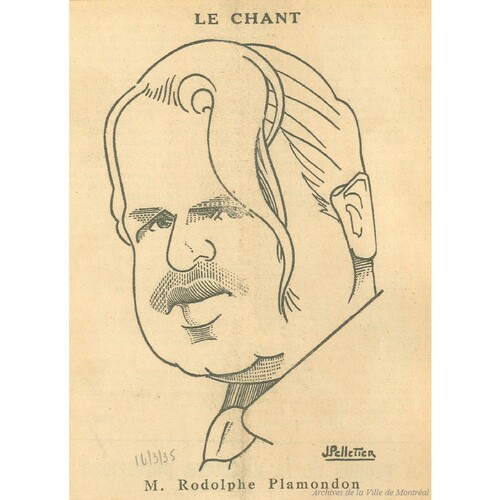
Source: Link
PLAMONDON, RODOLPHE (baptized Joseph-Marcel-Rodolphe), tenor, cellist, and teacher; b. 17 Jan. 1876 in Montreal, son of Théodore Plamondon and Virginie Cartier; m. 3 March 1904 in Paris mezzo-soprano and pianist Marie Dufriche, daughter of the French baritone Eugène Dufriche; he was survived by two sons and a daughter; d. 27 Jan. 1940 in Montreal.
Rodolphe Plamondon was born into a family in which music and culture occupied an important place. His father, a notary and violin aficionado, frequently organized chamber-music evenings in the family home. Between 1888 and 1892 Rodolphe received his classical education at the Petit Séminaire de Montréal, probably without graduating. He initially studied cello with Louis Charbonneau and solfège with Frédéric Pelletier before taking singing lessons from Guillaume Couture*, the composer and conductor who would come to be regarded as the first great musician in the history of Canadian music. Plamondon made occasional appearances as a vocal soloist at the cathedral of Saint-Jacques and Le Gesù church. In October 1895 he left for Europe. Accepted in December at the Rennes branch of the Conservatoire National de Musique et de Déclamation, in France, to study cello, he moved to Paris after a few months. In the summer of 1896 he secured his first professional engagements, as a cellist at the casino in Paramé (Saint-Malo) and then at the Folies-Parisiennes in Paris. Nevertheless, he continued taking voice lessons in that city; among his teachers was the tenor Pierre-Émile Engel, a student of the legendary tenor Gilbert-Louis Duprez, who had taught Emma Albani [Lajeunesse*]. He performed in French salons, where he met composers Jules Massenet and Reynaldo Hahn. In June 1897 he sang at Windsor Hall in London alongside Nellie Melba, an Australian, one of the international opera stars of the day. On 31 December he made his debut at the Dominican church on Rue du Faubourg Saint-Honoré in Paris, at a concert in which the baritone Jean-Baptiste Faure and the organist Charles-Marie Widor also performed. Increasingly, he appeared in the company of great singers of his generation, such as, for example, with Clara Ellen Butt and Paul-Henri Plançon at a recital in London’s Royal Albert Hall on 21 June 1898. At this time his career as an operatic singer in supporting roles took off – as for instance, in Vichy, France, in 1899. Back in Paris he found work as a cellist at the Casino de Paris and a tenor soloist at the church of Saint-Roch. In 1904 he married the French singer and pianist Marie Dufriche, who often accompanied him in his recitals.
On 2 Feb. 1904 a favourable review of a concert in the Salle Pleyel in Paris gave fresh impetus to Plamondon’s operatic career so that, more and more, he was given weightier roles, notably in Monte Carlo, where he played Laertes in Ambroise Thomas’s Hamlet in 1905 and Prince Sinodal in The demon by Anton Grigorievitch Rubinstein the following year. In 1905 at the ancient theatre of Orange, a European Mecca for theatrical productions and opera, he was an outstanding success as Iopas in Hector Berlioz’s Les Troyens à Carthage before an audience of 12,000. He would be regarded henceforth as one of the best interpreters of Berlioz’s music. Another significant breakthrough came when he made his debut at the Opéra de Paris in April 1906 in the title role in Berlioz’s La damnation de Faust, a part he would reprise more than 250 times during the course of his career. He returned to the Opéra de Paris in 1908 as Hippolyte in Jean-Philippe Rameau’s Hippolyte et Aricie, and again in 1918 as Castor in his Castor et Pollux. He thus became the first Canadian singer to perform in this major opera house, and only the second from the province of Quebec, after Albani, to gain international recognition. Plamondon was invited to appear as a soloist in France and elsewhere in Europe, especially by the Colonne and Lamoureux concert societies as well as the Société des Concerts du Conservatoire. He mostly sang works in the French repertory, but also performed an English work, Edward Elgar’s Dream of Gerontius.
In 1917 Plamondon met the famous French composer Camille Saint-Saëns, with whom he toured France that year. This encounter led to a close artistic bond and mutual esteem; together they performed the song cycle La cendre rouge. With Saint-Saëns as conductor, Plamondon was the soloist in the oratorio Le déluge. The composer dedicated one of his last works, “À saint Blaise,” to the Canadian tenor, who on 19 Oct. 1924 would perform it in Montreal. In the course of his career Plamondon also took part in some premieres: The dream of Gerontius at the Palais du Trocadéro in Paris in 1906, and “Harmonie du soir,” a poem by Charles Baudelaire set to music by the Canadian Rodolphe Mathieu and conducted by Paul Paray at the Lamoureux concerts in Paris in 1924.
In 1906 Plamondon gave two concerts in Canada, one at the Monument National in Montreal on 1 October and the other at the Auditorium de Québec on the 4th. It would be 14 years before he returned to his native land, with a solid international reputation. On 20 April 1920 he gave a recital at the Monument National. The next day Frédéric Pelletier, then the music critic for Montreal’s Le Devoir, wrote: “This art cannot be defined; it exists and the least knowledgeable in the audience feel its impact without being aware of it, attributing the feelings they experience to the voice alone, without suspecting that other[,] more beautiful voices would only succeed in rendering these pieces boring.” Three days later, to express the pride that his native province took in the achievements of one of its own, a banquet in his honour was held at the Hôtel Viger. From 1924 Plamondon sang mainly in Canada and gave many recitals in Quebec and New England, particularly with bass Ulysse Paquin. In 1930 he would tour Canada with his son Lucien, a cellist.
Around 1925, however, Plamondon’s performing career was nearing its end. He made a dozen records, mostly of French songs, for the Starr company. On 18 Jan. 1926 a benefit concert – “in national tribute to Rodolphe Plamondon,” as La Presse put it – was held at the Monument National. At the end of the recital, in which several Canadian artists performed, including Jean-Baptiste Dubois and his quartet as well as Plamondon himself, the tenor was presented with the entire proceeds for the evening, close to $2,000. In 1927 and 1928 he took part in the CPR Festivals at the Château Frontenac in Quebec City. He settled permanently in his home province in 1928, where he devoted himself to teaching in the 1930s. He is believed to have founded a school for voice training in Montreal and he taught at the École Supérieure de Musique d’Outremont from 1935 until his death in Montreal on 27 Jan. 1940.
Rodolphe Plamondon’s career also embraced great works of the sacred-music repertoire: César Franck’s Les Béatitudes, L’enfance du Christ by Berlioz, the Mass in B Minor and the two Passions (of St John and St Matthew) by Bach, Beethoven’s Missa solemnis, and Verdi’s Requiem. As well, he sang works that were rarely performed, such as the role of Adolar in Weber’s Euryanthe, with Vincent d’Indy as conductor. He is thought to have sung in the Wagner tetralogy in Spain and on a number of occasions he performed pieces by Canadian composers such as Alfred Laliberté and Rodolphe Mathieu. On 19 Jan. 1926 in Le Devoir, Pelletier succinctly summed up Rodolphe Plamondon’s art: “It is an art entirely free of the dazzling display of technique habitually resorted to [by] tenors who want mainly to show off their voices, and for whom the music is only a means. With [Plamondon], it is exactly the opposite; [his] voice, warm and enveloping, is simply an instrument in the service of the music that he interprets with a reverence [that is] by turns touching or serene.” Reviews of his concerts recall the purity, clarity, and expressiveness of the voice, a supple instrument that was remarkable for its mezza voce effects and its diction. A reserved artist of aristocratic bearing, Plamondon, in his day, was among “the most outstanding personalities [in the] world of music,” according to Le Devoir of 27 Sept. 1924. A street in Chicoutimi (Saguenay) would be named after him, as well as an avenue and a subway station in Montreal. In 1991 Plamondon was inducted into the Panthéon Canadien de l’Art Lyrique, which was founded that year by the Opéra de Montréal.
The author consulted the Plamondon family file in the Encyclopedia of music in Can. fonds (Univ. de Montréal, Div. des arch., P365). In addition to bibliographic references, the file includes among others things a copy of a program of Rodolphe Plamondon’s concert on 2 June 1927, correspondence with Ernest-Gill (Jean-Paul) Plamondon, the artist’s nephew, and with Benoît Plamondon, the family genealogist. This second set of letters contains complete genealogical information on, among others, the musicians of the family. According to these documents, the registry of the parish L’Ancienne-Lorette, Que., probably conceals the details of the first Plamondons who served music.
BANQ-CAM, CE601-S51, 19 janv. 1876; CN601-S492. FD, Notre-Dame (Montréal), 30 janv. 1940. Le Devoir (Montréal), 29 janv. 1940. Gazette (Montreal), 29 Jan. 1940. Le Passe-Temps (Montréal), 5 déc. 1914; 11 sept. 1915; 12 août 1916; 14 juill., 11 août 1917. La Presse, 29 janv. 1940. Gustave Comte, “Rodolphe Plamondon: esquisse biographique,” La Musique (Québec), 2 (1920): 135–37, 151–53, 167–70. Romain Gour, “Rodolphe Plamondon, ténor classique (1876–1940),” Qui? (Montréal), 5 (1953–54): 57–80. Historica Can., “The Canadian encyclopedia”: www.thecanadianencyclopedia.ca (consulted 18 Aug. 2015). Lanaudière – Sol de musique, “Joliette en musique”: soldemusique.connexion-lanaudiere.ca/sol/h6_joliette_4.htm (consulted 26 Aug. 2015). Georges Pioch, “‘Hippolyte et Aricie’ à l’Opéra,” Musica (Paris), 7 (1908): 85, 109. Jean Saucier, “Rodolphe Plamondon: un artiste canadien-français parmi les chanteurs favoris de l’Europe,” La Canadienne: le magazine du Canada français (Montréal), 1 (1920), no.5: 13.
Revisions based on:
BANQ preserves material related to Rodolphe Plamondon, including recordings that can be accessed in the Patrimoine québécois/Audio section of its digital collection: numerique.banq.qc.ca (consulted 21 Sept. 2018).
Arch. de Paris, “Actes d’état civil,” 9e arrondissement, 3 mars 1904, no.232: archives.paris.fr/s/4/etat-civil-actes/? (consulted 21 Sept. 2018).
Cite This Article
Pierre Vachon, “PLAMONDON, RODOLPHE (baptized Joseph-Marcel-Rodolphe),” in Dictionary of Canadian Biography, vol. 16, University of Toronto/Université Laval, 2003–, accessed December 31, 2025, https://www.biographi.ca/en/bio/plamondon_rodolphe_16E.html.
The citation above shows the format for footnotes and endnotes according to the Chicago manual of style (16th edition). Information to be used in other citation formats:
| Permalink: | https://www.biographi.ca/en/bio/plamondon_rodolphe_16E.html |
| Author of Article: | Pierre Vachon |
| Title of Article: | PLAMONDON, RODOLPHE (baptized Joseph-Marcel-Rodolphe) |
| Publication Name: | Dictionary of Canadian Biography, vol. 16 |
| Publisher: | University of Toronto/Université Laval |
| Year of publication: | 2018 |
| Year of revision: | 2018 |
| Access Date: | December 31, 2025 |





